lock BMW 340I XDRIVE SEDAN 2016 Owner's Manual
[x] Cancel search | Manufacturer: BMW, Model Year: 2016, Model line: 340I XDRIVE SEDAN, Model: BMW 340I XDRIVE SEDAN 2016Pages: 257, PDF Size: 5.55 MB
Page 64 of 257
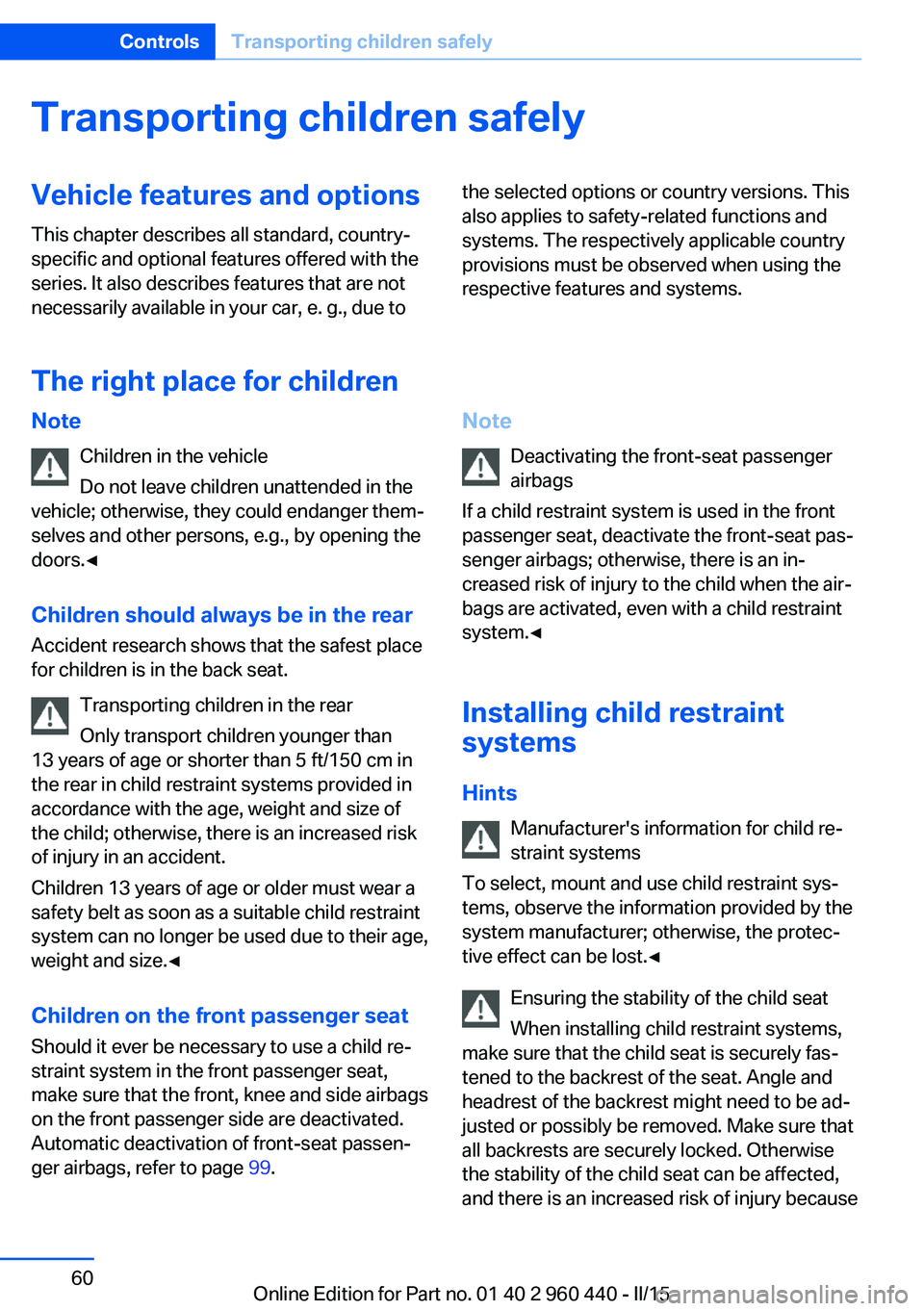
Transporting children safelyVehicle features and optionsThis chapter describes all standard, country-
specific and optional features offered with the
series. It also describes features that are not
necessarily available in your car, e. g., due tothe selected options or country versions. This
also applies to safety-related functions and
systems. The respectively applicable country
provisions must be observed when using the
respective features and systems.
The right place for children
Note
Children in the vehicle
Do not leave children unattended in the
vehicle; otherwise, they could endanger them‚Äź
selves and other persons, e.g., by opening the
doors.‚óÄ
Children should always be in the rear Accident research shows that the safest place
for children is in the back seat.
Transporting children in the rear
Only transport children younger than
13 years of age or shorter than 5 ft/150 cm in
the rear in child restraint systems provided in
accordance with the age, weight and size of
the child; otherwise, there is an increased risk
of injury in an accident.
Children 13 years of age or older must wear a
safety belt as soon as a suitable child restraint
system can no longer be used due to their age,
weight and size.‚óÄ
Children on the front passenger seat
Should it ever be necessary to use a child re‚Äź
straint system in the front passenger seat,
make sure that the front, knee and side airbags
on the front passenger side are deactivated.
Automatic deactivation of front-seat passen‚Äź
ger airbags, refer to page 99.Note
Deactivating the front-seat passenger
airbags
If a child restraint system is used in the front
passenger seat, deactivate the front-seat pas‚Äź
senger airbags; otherwise, there is an in‚Äź
creased risk of injury to the child when the air‚Äź
bags are activated, even with a child restraint
system.‚óÄ
Installing child restraint
systems
Hints Manufacturer's information for child re‚Äźstraint systems
To select, mount and use child restraint sys‚Äź
tems, observe the information provided by the
system manufacturer; otherwise, the protec‚Äź
tive effect can be lost.‚óÄ
Ensuring the stability of the child seat
When installing child restraint systems,
make sure that the child seat is securely fas‚Äź
tened to the backrest of the seat. Angle and
headrest of the backrest might need to be ad‚Äź
justed or possibly be removed. Make sure that
all backrests are securely locked. Otherwise
the stability of the child seat can be affected,
and there is an increased risk of injury becauseSeite 60ControlsTransporting children safely60
Online Edition for Part no. 01 40 2 960 440 - II/15
Page 65 of 257
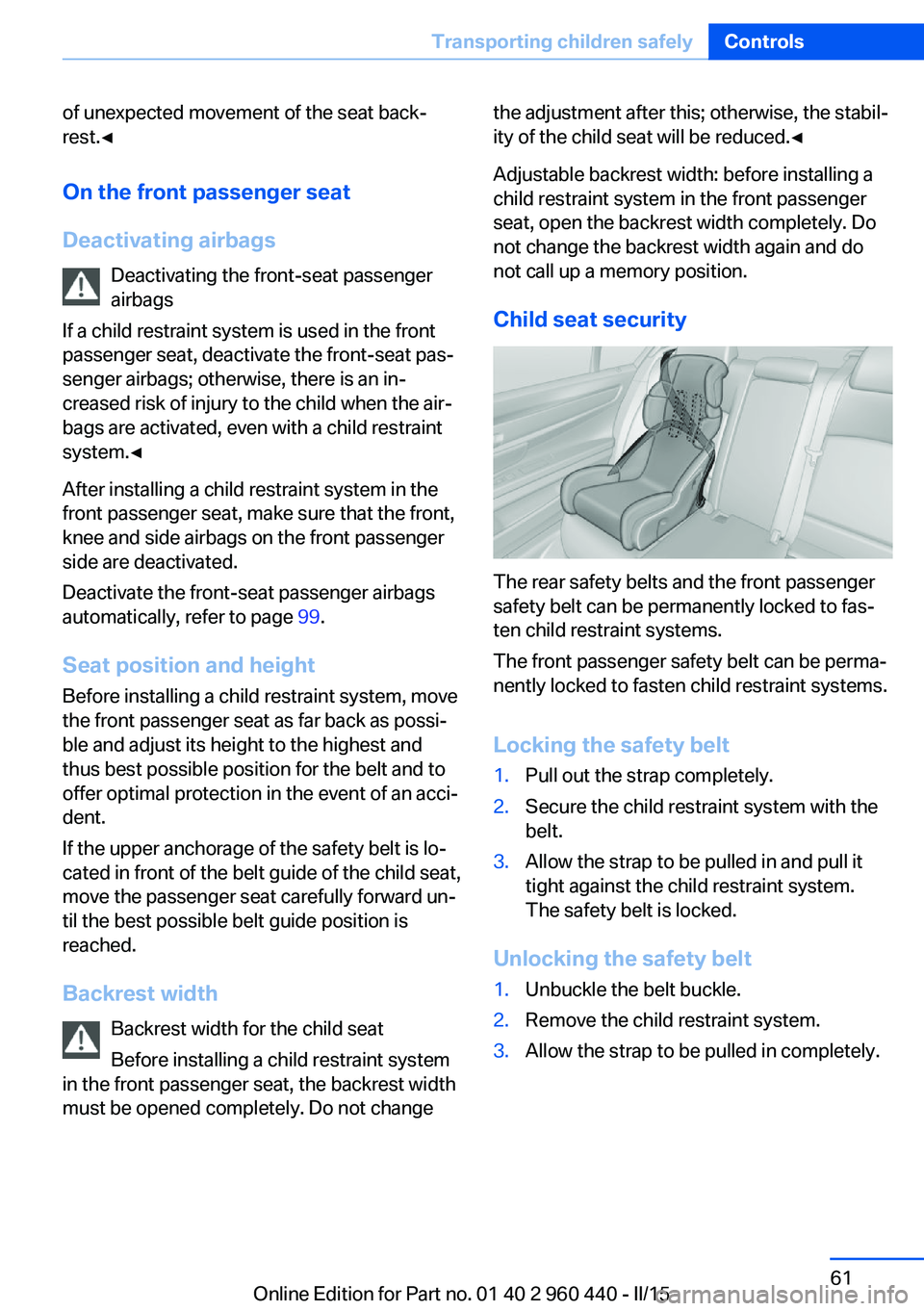
of unexpected movement of the seat back‚Äź
rest.‚óÄ
On the front passenger seat
Deactivating airbags Deactivating the front-seat passenger
airbags
If a child restraint system is used in the front
passenger seat, deactivate the front-seat pas‚Äź
senger airbags; otherwise, there is an in‚Äź
creased risk of injury to the child when the air‚Äź
bags are activated, even with a child restraint
system.‚óÄ
After installing a child restraint system in the
front passenger seat, make sure that the front,
knee and side airbags on the front passenger
side are deactivated.
Deactivate the front-seat passenger airbags automatically, refer to page 99.
Seat position and height
Before installing a child restraint system, move
the front passenger seat as far back as possi‚Äź
ble and adjust its height to the highest and
thus best possible position for the belt and to
offer optimal protection in the event of an acci‚Äź
dent.
If the upper anchorage of the safety belt is lo‚Äź
cated in front of the belt guide of the child seat,
move the passenger seat carefully forward un‚Äź
til the best possible belt guide position is
reached.
Backrest width Backrest width for the child seat
Before installing a child restraint system
in the front passenger seat, the backrest width
must be opened completely. Do not changethe adjustment after this; otherwise, the stabil‚Äź
ity of the child seat will be reduced.‚óÄ
Adjustable backrest width: before installing a
child restraint system in the front passenger
seat, open the backrest width completely. Do
not change the backrest width again and do
not call up a memory position.
Child seat security
The rear safety belts and the front passenger
safety belt can be permanently locked to fas‚Äź
ten child restraint systems.
The front passenger safety belt can be perma‚Äź
nently locked to fasten child restraint systems.
Locking the safety belt
1.Pull out the strap completely.2.Secure the child restraint system with the
belt.3.Allow the strap to be pulled in and pull it
tight against the child restraint system.
The safety belt is locked.
Unlocking the safety belt
1.Unbuckle the belt buckle.2.Remove the child restraint system.3.Allow the strap to be pulled in completely.Seite 61Transporting children safelyControls61
Online Edition for Part no. 01 40 2 960 440 - II/15
Page 67 of 257
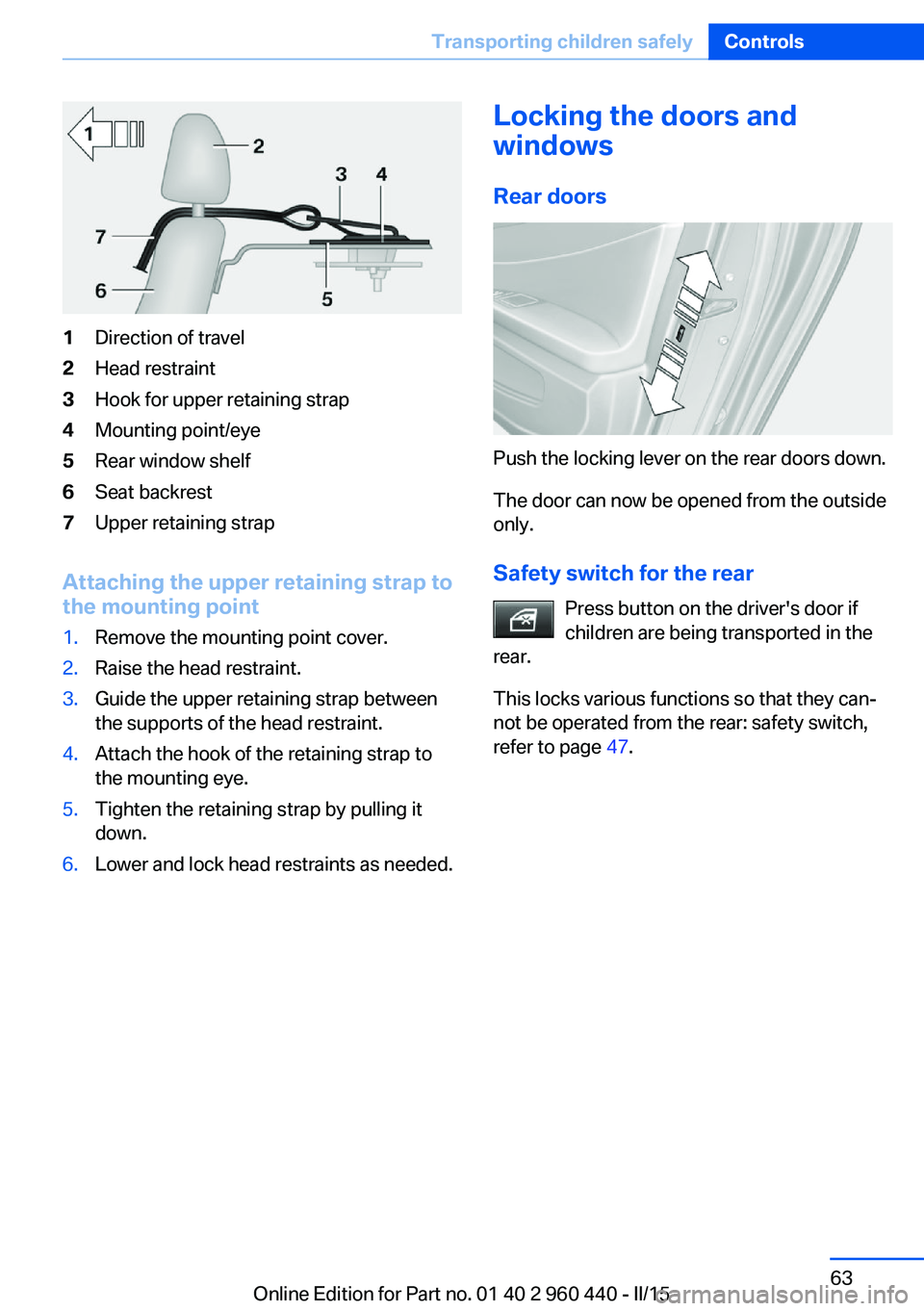
1Direction of travel2Head restraint3Hook for upper retaining strap4Mounting point/eye5Rear window shelf6Seat backrest7Upper retaining strap
Attaching the upper retaining strap to
the mounting point
1.Remove the mounting point cover.2.Raise the head restraint.3.Guide the upper retaining strap between
the supports of the head restraint.4.Attach the hook of the retaining strap to
the mounting eye.5.Tighten the retaining strap by pulling it
down.6.Lower and lock head restraints as needed.Locking the doors and
windows
Rear doors
Push the locking lever on the rear doors down.
The door can now be opened from the outside
only.
Safety switch for the rear Press button on the driver's door if
children are being transported in the
rear.
This locks various functions so that they can‚Äź
not be operated from the rear: safety switch,
refer to page 47.
Seite 63Transporting children safelyControls63
Online Edition for Part no. 01 40 2 960 440 - II/15
Page 68 of 257
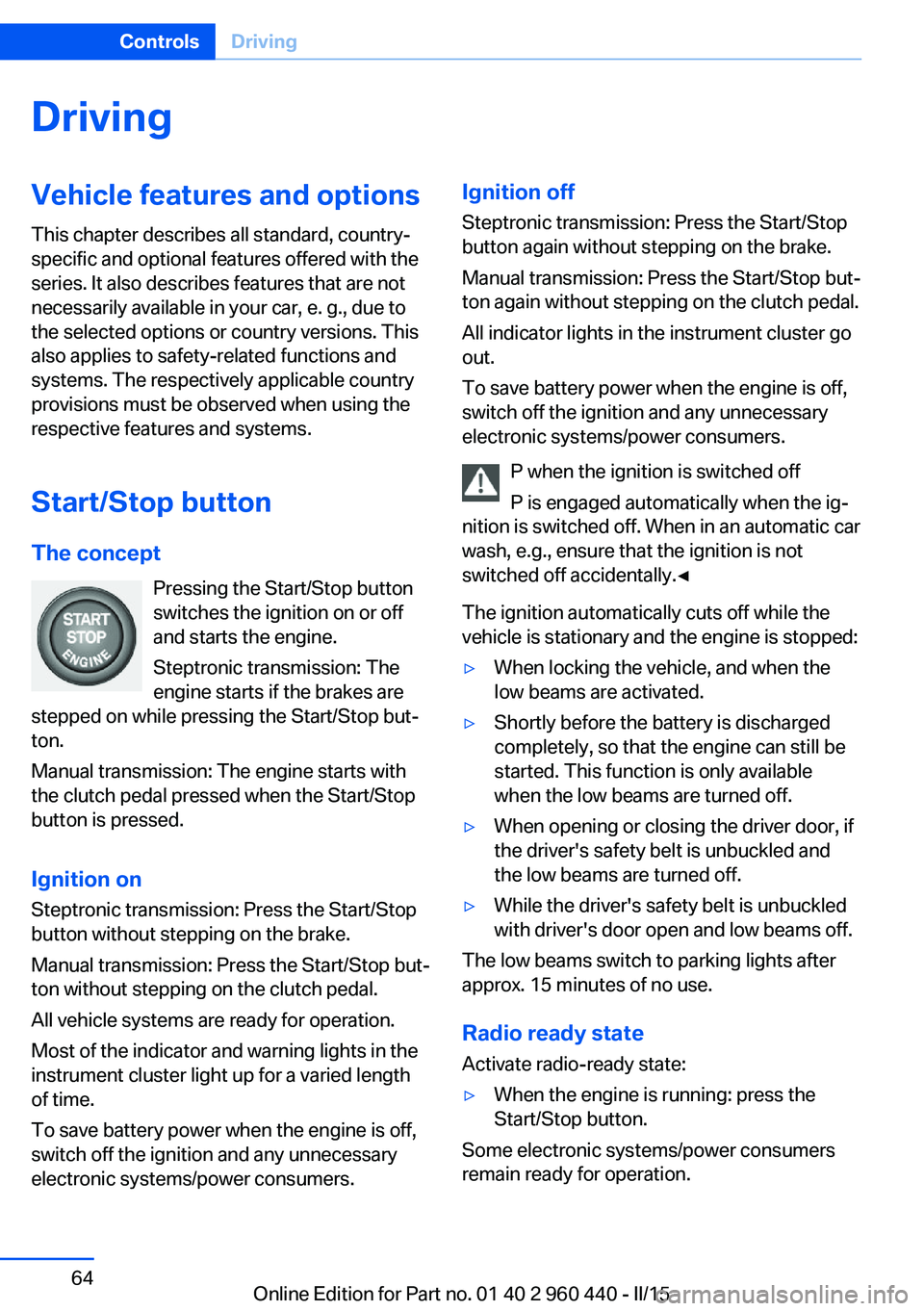
DrivingVehicle features and options
This chapter describes all standard, country-
specific and optional features offered with the
series. It also describes features that are not
necessarily available in your car, e. g., due to
the selected options or country versions. This
also applies to safety-related functions and
systems. The respectively applicable country
provisions must be observed when using the
respective features and systems.
Start/Stop button The concept Pressing the Start/Stop button
switches the ignition on or off
and starts the engine.
Steptronic transmission: The
engine starts if the brakes are
stepped on while pressing the Start/Stop but‚Äź
ton.
Manual transmission: The engine starts with
the clutch pedal pressed when the Start/Stop
button is pressed.
Ignition onSteptronic transmission: Press the Start/Stop
button without stepping on the brake.
Manual transmission: Press the Start/Stop but‚Äź
ton without stepping on the clutch pedal.
All vehicle systems are ready for operation.
Most of the indicator and warning lights in the
instrument cluster light up for a varied length
of time.
To save battery power when the engine is off,
switch off the ignition and any unnecessary
electronic systems/power consumers.Ignition off
Steptronic transmission: Press the Start/Stop
button again without stepping on the brake.
Manual transmission: Press the Start/Stop but‚Äź
ton again without stepping on the clutch pedal.
All indicator lights in the instrument cluster go
out.
To save battery power when the engine is off,
switch off the ignition and any unnecessary
electronic systems/power consumers.
P when the ignition is switched off
P is engaged automatically when the ig‚Äź
nition is switched off. When in an automatic car wash, e.g., ensure that the ignition is not
switched off accidentally.‚óÄ
The ignition automatically cuts off while the
vehicle is stationary and the engine is stopped:‚Ė∑When locking the vehicle, and when the
low beams are activated.‚Ė∑Shortly before the battery is discharged
completely, so that the engine can still be
started. This function is only available
when the low beams are turned off.‚Ė∑When opening or closing the driver door, if
the driver's safety belt is unbuckled and
the low beams are turned off.‚Ė∑While the driver's safety belt is unbuckled
with driver's door open and low beams off.
The low beams switch to parking lights after
approx. 15 minutes of no use.
Radio ready state
Activate radio-ready state:
‚Ė∑When the engine is running: press the
Start/Stop button.
Some electronic systems/power consumers
remain ready for operation.
Seite 64ControlsDriving64
Online Edition for Part no. 01 40 2 960 440 - II/15
Page 69 of 257
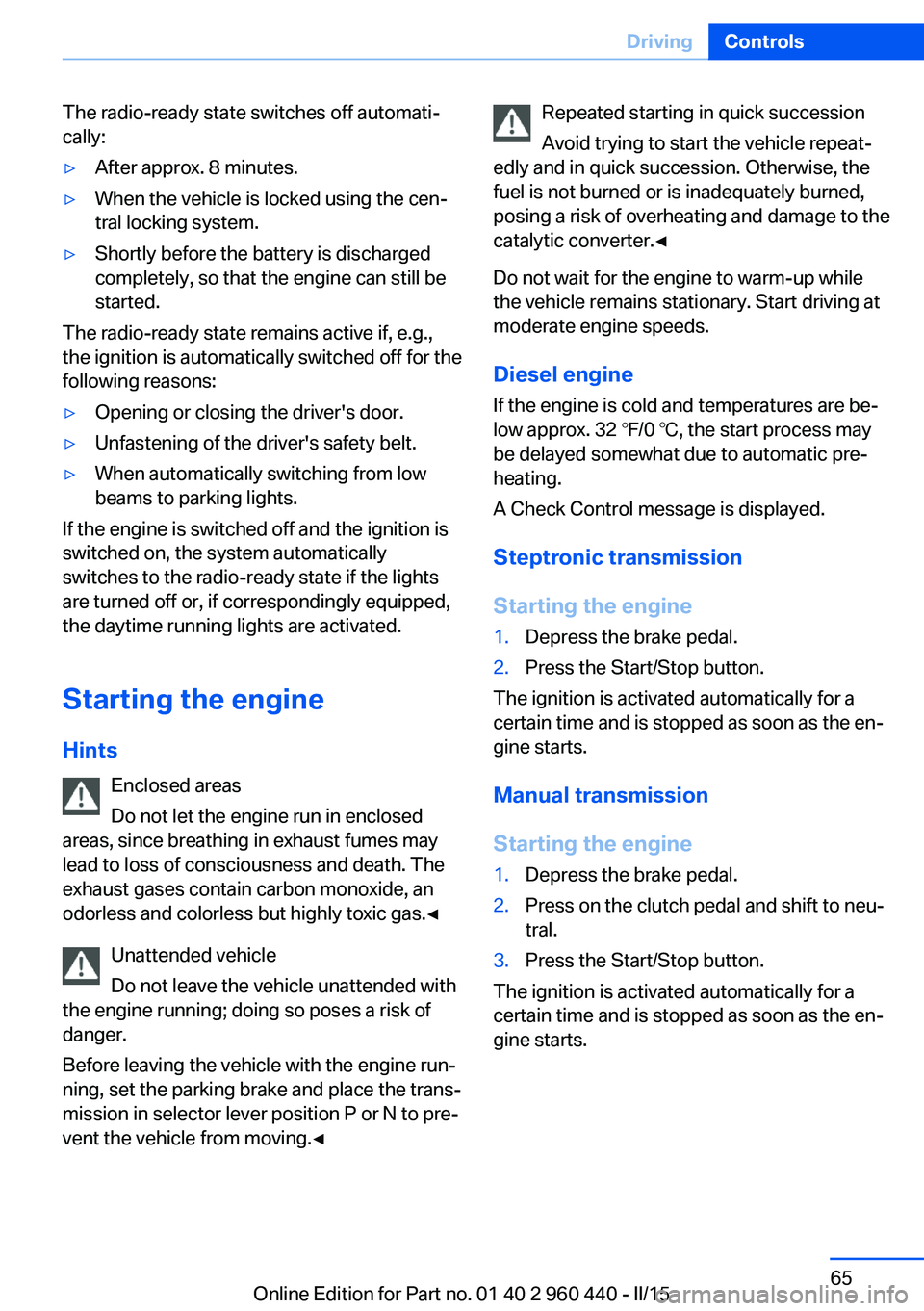
The radio-ready state switches off automati‚Äź
cally:‚Ė∑After approx. 8 minutes.‚Ė∑When the vehicle is locked using the cen‚Äź
tral locking system.‚Ė∑Shortly before the battery is discharged
completely, so that the engine can still be
started.
The radio-ready state remains active if, e.g.,
the ignition is automatically switched off for the
following reasons:
‚Ė∑Opening or closing the driver's door.‚Ė∑Unfastening of the driver's safety belt.‚Ė∑When automatically switching from low
beams to parking lights.
If the engine is switched off and the ignition is
switched on, the system automatically
switches to the radio-ready state if the lights
are turned off or, if correspondingly equipped,
the daytime running lights are activated.
Starting the engine
Hints Enclosed areas
Do not let the engine run in enclosed
areas, since breathing in exhaust fumes may
lead to loss of consciousness and death. The
exhaust gases contain carbon monoxide, an
odorless and colorless but highly toxic gas.‚óÄ
Unattended vehicle
Do not leave the vehicle unattended with
the engine running; doing so poses a risk of
danger.
Before leaving the vehicle with the engine run‚Äź
ning, set the parking brake and place the trans‚Äź
mission in selector lever position P or N to pre‚Äź
vent the vehicle from moving.‚óÄ
Repeated starting in quick succession
Avoid trying to start the vehicle repeat‚Äź
edly and in quick succession. Otherwise, the
fuel is not burned or is inadequately burned,
posing a risk of overheating and damage to the
catalytic converter.‚óÄ
Do not wait for the engine to warm-up while
the vehicle remains stationary. Start driving at
moderate engine speeds.
Diesel engine
If the engine is cold and temperatures are be‚Äź
low approx. 32 ‚ĄČ/0 ‚ĄÉ, the start process may
be delayed somewhat due to automatic pre‚Äź
heating.
A Check Control message is displayed.
Steptronic transmission
Starting the engine1.Depress the brake pedal.2.Press the Start/Stop button.
The ignition is activated automatically for a
certain time and is stopped as soon as the en‚Äź
gine starts.
Manual transmission
Starting the engine
1.Depress the brake pedal.2.Press on the clutch pedal and shift to neu‚Äź
tral.3.Press the Start/Stop button.
The ignition is activated automatically for a
certain time and is stopped as soon as the en‚Äź
gine starts.
Seite 65DrivingControls65
Online Edition for Part no. 01 40 2 960 440 - II/15
Page 71 of 257
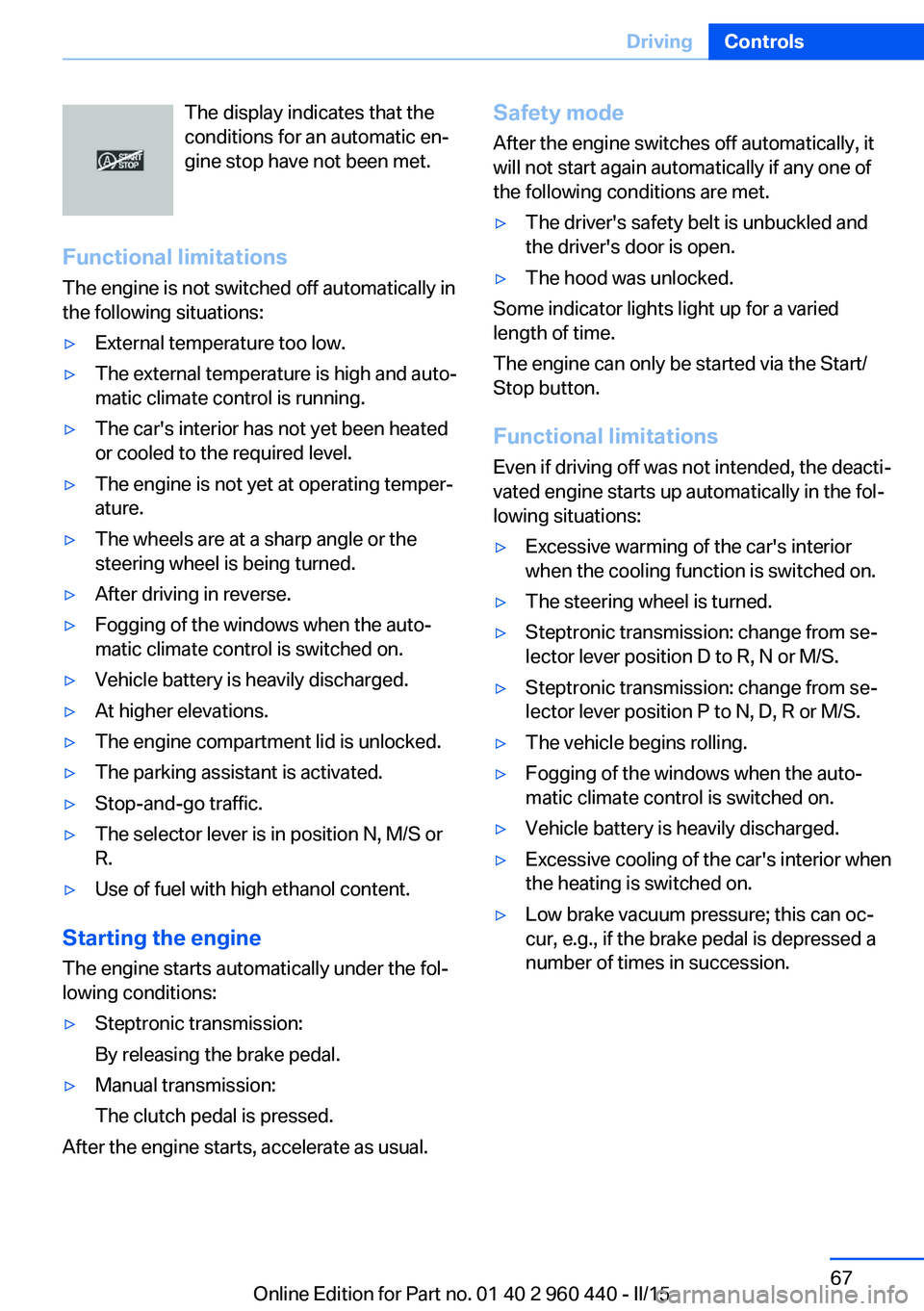
The display indicates that the
conditions for an automatic en‚Äź
gine stop have not been met.
Functional limitations
The engine is not switched off automatically in
the following situations:‚Ė∑External temperature too low.‚Ė∑The external temperature is high and auto‚Äź
matic climate control is running.‚Ė∑The car's interior has not yet been heated
or cooled to the required level.‚Ė∑The engine is not yet at operating temper‚Äź
ature.‚Ė∑The wheels are at a sharp angle or the
steering wheel is being turned.‚Ė∑After driving in reverse.‚Ė∑Fogging of the windows when the auto‚Äź
matic climate control is switched on.‚Ė∑Vehicle battery is heavily discharged.‚Ė∑At higher elevations.‚Ė∑The engine compartment lid is unlocked.‚Ė∑The parking assistant is activated.‚Ė∑Stop-and-go traffic.‚Ė∑The selector lever is in position N, M/S or
R.‚Ė∑Use of fuel with high ethanol content.
Starting the engine
The engine starts automatically under the fol‚Äź
lowing conditions:
‚Ė∑Steptronic transmission:
By releasing the brake pedal.‚Ė∑Manual transmission:
The clutch pedal is pressed.
After the engine starts, accelerate as usual.
Safety mode
After the engine switches off automatically, it
will not start again automatically if any one of
the following conditions are met.‚Ė∑The driver's safety belt is unbuckled and
the driver's door is open.‚Ė∑The hood was unlocked.
Some indicator lights light up for a varied
length of time.
The engine can only be started via the Start/
Stop button.
Functional limitations
Even if driving off was not intended, the deacti‚Äź
vated engine starts up automatically in the fol‚Äź
lowing situations:
‚Ė∑Excessive warming of the car's interior
when the cooling function is switched on.‚Ė∑The steering wheel is turned.‚Ė∑Steptronic transmission: change from se‚Äź
lector lever position D to R, N or M/S.‚Ė∑Steptronic transmission: change from se‚Äź
lector lever position P to N, D, R or M/S.‚Ė∑The vehicle begins rolling.‚Ė∑Fogging of the windows when the auto‚Äź
matic climate control is switched on.‚Ė∑Vehicle battery is heavily discharged.‚Ė∑Excessive cooling of the car's interior when
the heating is switched on.‚Ė∑Low brake vacuum pressure; this can oc‚Äź
cur, e.g., if the brake pedal is depressed a
number of times in succession.Seite 67DrivingControls67
Online Edition for Part no. 01 40 2 960 440 - II/15
Page 72 of 257
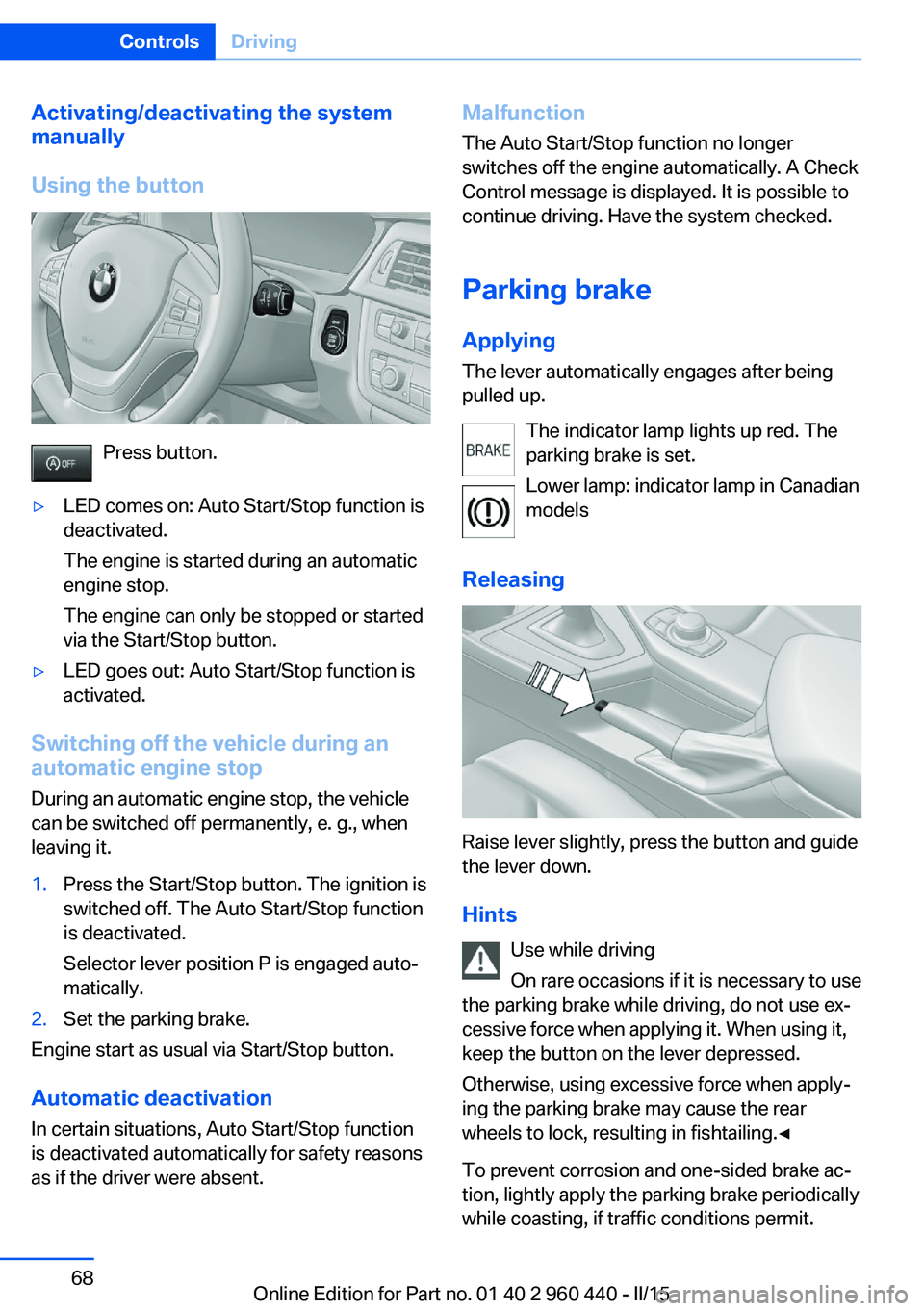
Activating/deactivating the system
manually
Using the button
Press button.
‚Ė∑LED comes on: Auto Start/Stop function is
deactivated.
The engine is started during an automatic
engine stop.
The engine can only be stopped or started
via the Start/Stop button.‚Ė∑LED goes out: Auto Start/Stop function is
activated.
Switching off the vehicle during an
automatic engine stop
During an automatic engine stop, the vehicle
can be switched off permanently, e. g., when
leaving it.
1.Press the Start/Stop button. The ignition is
switched off. The Auto Start/Stop function
is deactivated.
Selector lever position P is engaged auto‚Äź
matically.2.Set the parking brake.
Engine start as usual via Start/Stop button.
Automatic deactivation
In certain situations, Auto Start/Stop function
is deactivated automatically for safety reasons
as if the driver were absent.
Malfunction
The Auto Start/Stop function no longer
switches off the engine automatically. A Check Control message is displayed. It is possible to
continue driving. Have the system checked.
Parking brake Applying
The lever automatically engages after being pulled up.
The indicator lamp lights up red. The
parking brake is set.
Lower lamp: indicator lamp in Canadian
models
Releasing
Raise lever slightly, press the button and guide
the lever down.
Hints Use while driving
On rare occasions if it is necessary to use
the parking brake while driving, do not use ex‚Äź
cessive force when applying it. When using it,
keep the button on the lever depressed.
Otherwise, using excessive force when apply‚Äź
ing the parking brake may cause the rear
wheels to lock, resulting in fishtailing.‚óÄ
To prevent corrosion and one-sided brake ac‚Äź
tion, lightly apply the parking brake periodically
while coasting, if traffic conditions permit.
Seite 68ControlsDriving68
Online Edition for Part no. 01 40 2 960 440 - II/15
Page 76 of 257
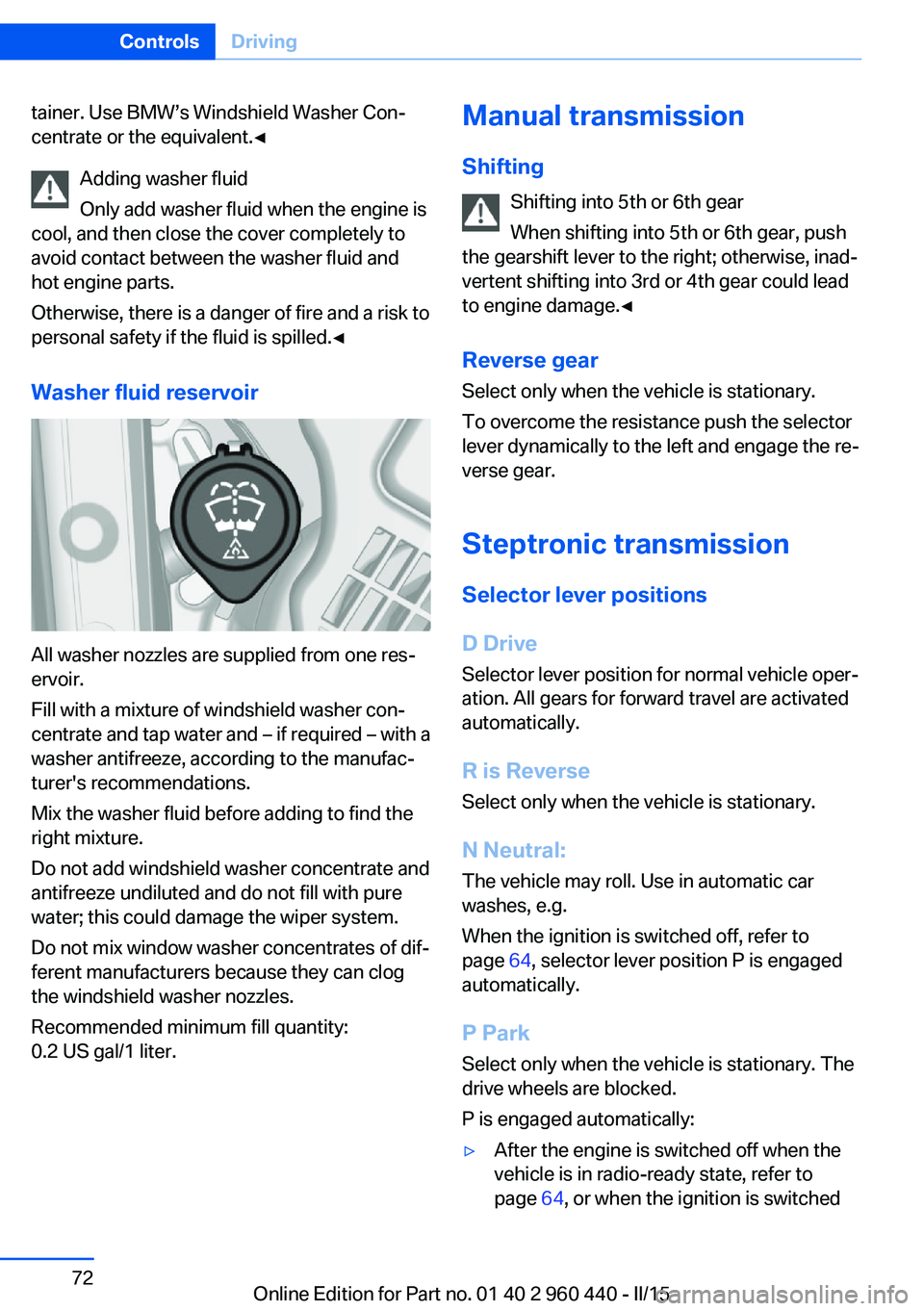
tainer. Use BMW‚Äôs Windshield Washer Con‚Äź
centrate or the equivalent.‚óÄ
Adding washer fluid
Only add washer fluid when the engine is
cool, and then close the cover completely to
avoid contact between the washer fluid and
hot engine parts.
Otherwise, there is a danger of fire and a risk to
personal safety if the fluid is spilled.‚óÄ
Washer fluid reservoir
All washer nozzles are supplied from one res‚Äź
ervoir.
Fill with a mixture of windshield washer con‚Äź
centrate and tap water and ‚Äď if required ‚Äď with a
washer antifreeze, according to the manufac‚Äź
turer's recommendations.
Mix the washer fluid before adding to find the
right mixture.
Do not add windshield washer concentrate and
antifreeze undiluted and do not fill with pure
water; this could damage the wiper system.
Do not mix window washer concentrates of dif‚Äź
ferent manufacturers because they can clog
the windshield washer nozzles.
Recommended minimum fill quantity:
0.2 US gal/1 liter.
Manual transmission
Shifting Shifting into 5th or 6th gear
When shifting into 5th or 6th gear, push
the gearshift lever to the right; otherwise, inad‚Äź
vertent shifting into 3rd or 4th gear could lead
to engine damage.‚óÄ
Reverse gear
Select only when the vehicle is stationary.
To overcome the resistance push the selector
lever dynamically to the left and engage the re‚Äź
verse gear.
Steptronic transmission
Selector lever positions
D Drive
Selector lever position for normal vehicle oper‚Äź
ation. All gears for forward travel are activated
automatically.
R is Reverse
Select only when the vehicle is stationary.
N Neutral: The vehicle may roll. Use in automatic car
washes, e.g.
When the ignition is switched off, refer to
page 64, selector lever position P is engaged
automatically.
P Park Select only when the vehicle is stationary. The
drive wheels are blocked.
P is engaged automatically:‚Ė∑After the engine is switched off when the
vehicle is in radio-ready state, refer to
page 64, or when the ignition is switchedSeite 72ControlsDriving72
Online Edition for Part no. 01 40 2 960 440 - II/15
Page 77 of 257
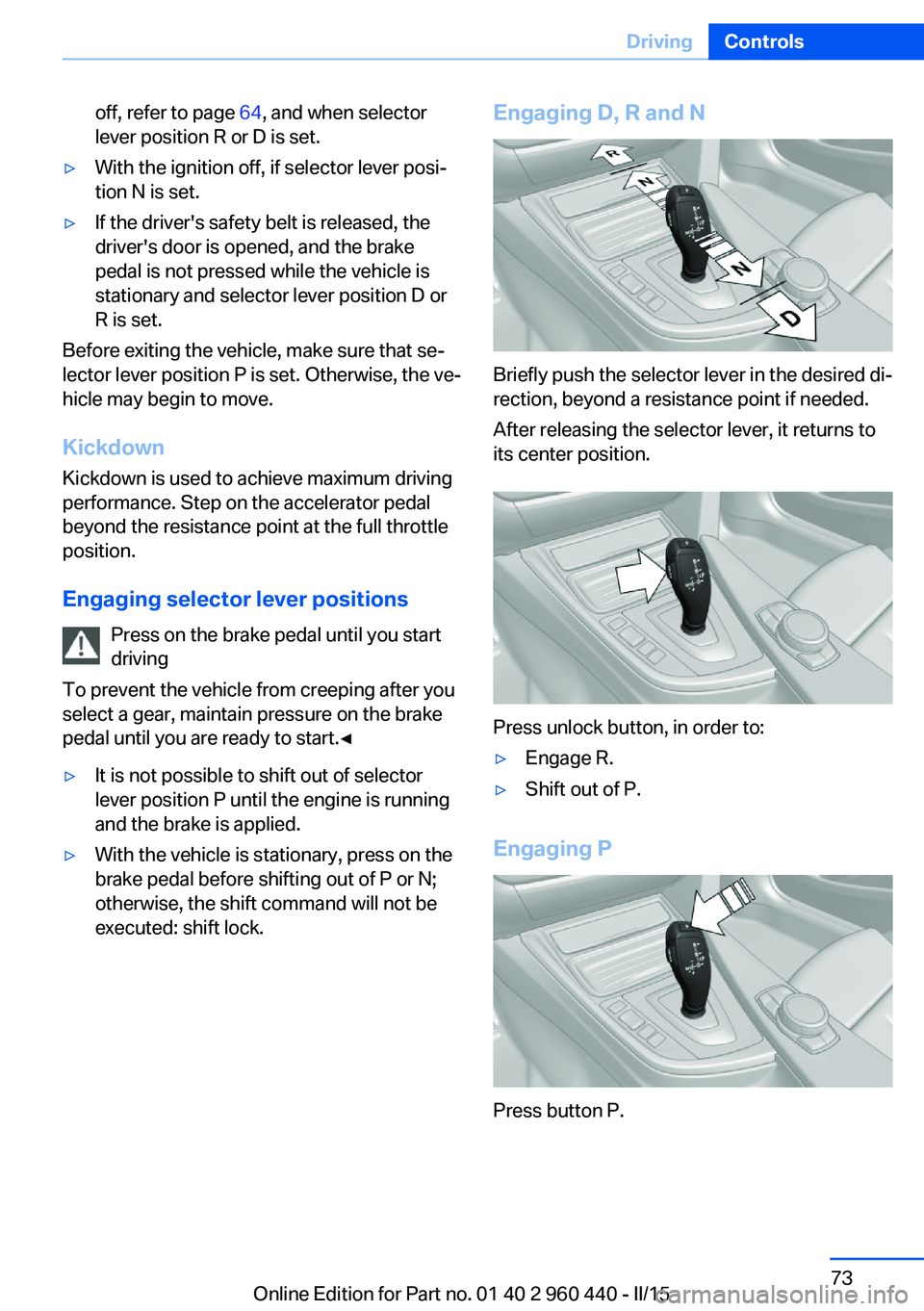
off, refer to page 64, and when selector
lever position R or D is set.‚Ė∑With the ignition off, if selector lever posi‚Äź
tion N is set.‚Ė∑If the driver's safety belt is released, the
driver's door is opened, and the brake
pedal is not pressed while the vehicle is
stationary and selector lever position D or
R is set.
Before exiting the vehicle, make sure that se‚Äź
lector lever position P is set. Otherwise, the ve‚Äź
hicle may begin to move.
Kickdown Kickdown is used to achieve maximum driving
performance. Step on the accelerator pedal
beyond the resistance point at the full throttle
position.
Engaging selector lever positions Press on the brake pedal until you start
driving
To prevent the vehicle from creeping after you
select a gear, maintain pressure on the brake
pedal until you are ready to start.‚óÄ
‚Ė∑It is not possible to shift out of selector
lever position P until the engine is running
and the brake is applied.‚Ė∑With the vehicle is stationary, press on the
brake pedal before shifting out of P or N;
otherwise, the shift command will not be
executed: shift lock.Engaging D, R and N
Briefly push the selector lever in the desired di‚Äź
rection, beyond a resistance point if needed.
After releasing the selector lever, it returns to
its center position.
Press unlock button, in order to:
‚Ė∑Engage R.‚Ė∑Shift out of P.
Engaging P
Press button P.
Seite 73DrivingControls73
Online Edition for Part no. 01 40 2 960 440 - II/15
Page 79 of 257
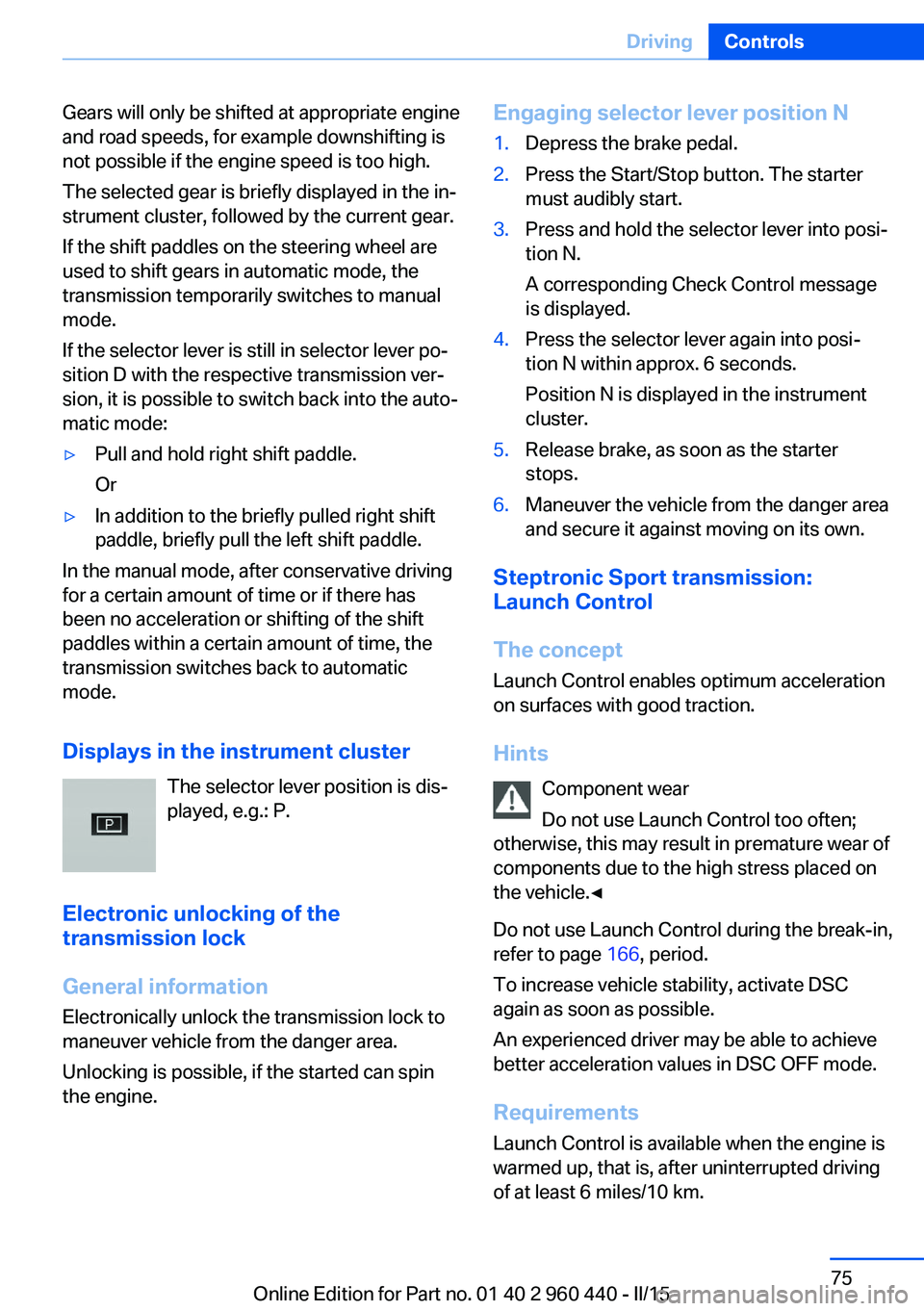
Gears will only be shifted at appropriate engine
and road speeds, for example downshifting is
not possible if the engine speed is too high.
The selected gear is briefly displayed in the in‚Äź
strument cluster, followed by the current gear.
If the shift paddles on the steering wheel are
used to shift gears in automatic mode, the
transmission temporarily switches to manual
mode.
If the selector lever is still in selector lever po‚Äź
sition D with the respective transmission ver‚Äź
sion, it is possible to switch back into the auto‚Äź
matic mode:‚Ė∑Pull and hold right shift paddle.
Or‚Ė∑In addition to the briefly pulled right shift
paddle, briefly pull the left shift paddle.
In the manual mode, after conservative driving
for a certain amount of time or if there has
been no acceleration or shifting of the shift
paddles within a certain amount of time, the
transmission switches back to automatic
mode.
Displays in the instrument cluster The selector lever position is dis‚Äź
played, e.g.: P.
Electronic unlocking of the
transmission lock
General information
Electronically unlock the transmission lock to
maneuver vehicle from the danger area.
Unlocking is possible, if the started can spin
the engine.
Engaging selector lever position N1.Depress the brake pedal.2.Press the Start/Stop button. The starter
must audibly start.3.Press and hold the selector lever into posi‚Äź
tion N.
A corresponding Check Control message
is displayed.4.Press the selector lever again into posi‚Äź
tion N within approx. 6 seconds.
Position N is displayed in the instrument
cluster.5.Release brake, as soon as the starter
stops.6.Maneuver the vehicle from the danger area
and secure it against moving on its own.
Steptronic Sport transmission:
Launch Control
The concept Launch Control enables optimum accelerationon surfaces with good traction.
Hints Component wear
Do not use Launch Control too often;
otherwise, this may result in premature wear of
components due to the high stress placed on
the vehicle.‚óÄ
Do not use Launch Control during the break-in,
refer to page 166, period.
To increase vehicle stability, activate DSC
again as soon as possible.
An experienced driver may be able to achieve
better acceleration values in DSC OFF mode.
Requirements Launch Control is available when the engine is
warmed up, that is, after uninterrupted driving
of at least 6 miles/10 km.
Seite 75DrivingControls75
Online Edition for Part no. 01 40 2 960 440 - II/15